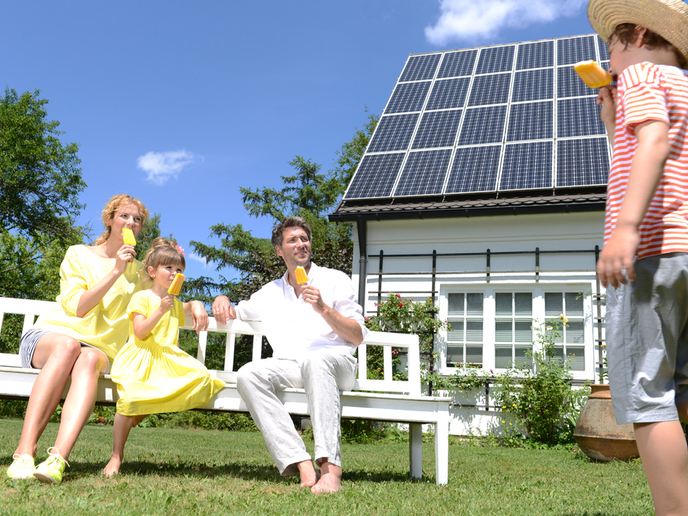Why are solar panels blue?
Technically, solar panels aren’t blue. They just look that way to us. “When we see colour, we’re actually seeing the light being reflected from a material,” says Sarah McCormack, associate professor at Trinity College Dublin. As McCormack explains, a solar panel absorbs from a wide range of light wavelengths, essentially a rainbow of different colours of light. Any light that isn’t absorbed is reflected, which the human eye perceives as being a dark or navy blue. “The vast majority of solar panels you see on a roof or in a field are made from silicon,” adds McCormack. “It’s the nature of a silicon wafer to reflect a dark blue or navy blue colour.” While silicon excels at absorbing light from a large swath of the wavelengths, it doesn’t do it very efficiently. In fact, silicon has a theoretical efficiency of around just 30 %. “In other words, silicon does a great job absorbing light but doesn’t convert that light into electricity as efficiently as we would like it to,” says McCormack.
New materials for increased efficiency
That being said, silicon solar panels have become remarkably more efficient over time. Just 10 years ago you might remember solar panels being blue and shiny, and maybe even a little garish. But today, these polycrystalline panels have largely been replaced by monocrystalline panels. Made from pure silicon, monocrystalline panels are more efficient and effective than the panels of the past. However, there’s still room for improvement, which is why researchers like McCormack are looking beyond silicon and investigating different types of materials that could increase efficiency levels. “You can’t make silicon cells more than 30 % efficient, but you can create more efficient materials,” explains McCormack. Unlike silicon, which absorbs light from across the light spectrum, these new materials look to absorb a particular colour or just part of a wavelength. “You take one cell that captures red light, another that can capture green light, put them together and, in theory, what you get is a panel capable of absorbing the entire electromagnetic spectrum at a very high level of efficiency,” remarks McCormack. One of those materials is perovskite, a material that has the same crystal structure as the mineral composed of calcium titanate. The EU-funded PERTPV project is using this material to build a new type of stackable solar cell that could result in a more powerful, efficient and sustainable solar panel. “When used as an absorber material, perovskites have proven capable of producing highly efficient cells, almost matching the efficiency of traditional silicon cells,” Henry Snaith, a professor from Oxford University, tells CORDIS.
No more reflecting the blues
For McCormack’s part, she is working on improving solar panel efficiency using luminescent glazing. “Different luminescent glazes allow us to capture different wavelengths of light, which could help us make solar panels more efficient, particularly for use in cloudy conditions,” she says. These luminescent glazes could also open the door to different coloured solar panels. “Part of increasing efficiency means using more panels, but there’s only so much space on a roof,” adds McCormack. “Aesthetically appeasing, colourful panels can be easily incorporated into building facades, greatly increasing the surface space available for installing solar panels.” If successful, the days of dark blue solar panels could be limited. Instead, solar panels may be just as colourful as the wavelengths of light. Click here to find out more about McCormack’s research: The colourful facades powering the solar buildings of tomorrow
Keywords
PEDAL, solar panel, light wavelengths, silicon, electricity, polycrystalline panels, monocrystalline panels, perovskite, PERTPV



